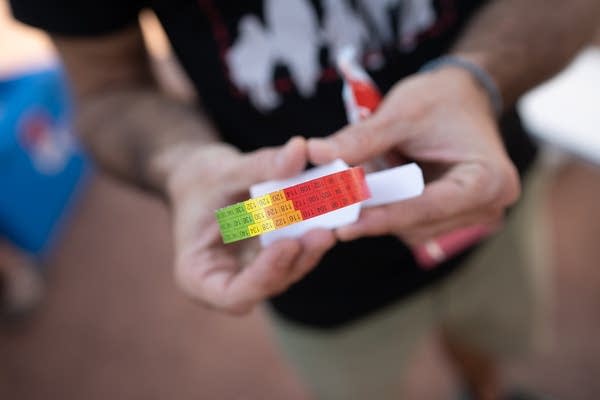Exhibit offers visitors a taste of refugee life

Go Deeper.
Create an account or log in to save stories.
Like this?
Thanks for liking this story! We have added it to a list of your favorite stories.
The Commons Park in Minneapolis has been transformed to simulate a refugee's journey.
A new exhibit, called "Forced From Home," is now open in the park along the approaches to U.S. Bank Stadium. The medical relief agency Doctors Without Borders is presenting the exhibit to give visitors a chance to experience what it's like to flee war and violence and live like a refugee.
When visitors enter, they're assigned a legal status: Internally displaced person. Asylum seeker. Refugee.

"These are complex terms," said Mark Leirer, a guide team leader and a nurse who's been working with Doctors Without Borders. "They're loaded terms, they're terms that are often misused."
Turn Up Your Support
MPR News helps you turn down the noise and build shared understanding. Turn up your support for this public resource and keep trusted journalism accessible to all.
Leirer said the exhibit is meant "to create a human moment and to show that the people who are leaving these places and the people who are forced from their homes are people just like you and me. And it's probably for a good reason that they're leaving, but we have to understand what that is. And we can't judge and assume until we understand."
The "Forced From Home" exhibit opened this week and runs through Sunday. It focuses on the factors that push people out of their homes — as experienced through the displacement crises in Syria, Afghanistan, Burundi, South Sudan and Honduras.
Leirer said while the conditions that create such crises vary from war and violence to ethnic tension and economic instability, they're all connected.
"So it tends to mean that when one thing happens, it rolls into all the other ones," he explained. "And this is when that fever-pitch moment comes — when people realize that there is just no more chance of living in the place they're in, and the only real reality is to seek safety elsewhere by leaving."

Earlier this week, a group of sixth-graders from a charter school, the Mastery School in north Minneapolis, toured the exhibit. They encountered a display of cards representing household essentials. The students had only 30 seconds to pick five items they'd grab in a hurry, if they were forced to run.
"You must leave everything else behind," instructed a tour guide. "And we're going to meet over here. Let's meet over here for safety."
But the students couldn't hang on even to all of those meager possessions. In the rush of their escape, they were told, they had to drop first one card, then another. And they continued to drop items through the treacherous journey.
The idea is to get a sense of what it feels like to be shaken out of your bed and have to grab what you can.
The exhibit displays a boat similar to what thousands of people used to cross the Mediterranean into Greece during the height of the European refugee crisis. There is a pile of life vests representing those abandoned on the shore a couple of years ago.

Leirer uses each one of the stops as an opportunity to talk about the larger displacement crisis.
"These boats themselves, when they launch from the Libyan coast, if they do not encounter a search and rescue vessel like ours, they do not make it to land," he said. "They perish at sea."
From there, visitors move on to a makeshift border fence. People who were assigned an internally displaced identity stand on one side; asylum seekers and refugees stand on the other.
Leirer said this part of the exhibit explains what it means to be "stateless" — like the 700,000 Rohingya Muslims who fled persecution from Myanmar last year. "This is incredibly important, because it's very poignant to the current moment," he said.
At the end of the refugee journey stand examples of so-called final destinations like a basic camp made of scraps of cloth and plastic sheeting, as typically seen in Mogadishu, or a more modern tent, as typically seen in France.
A panel discussion with Doctors Without Borders is set for 7:30 p.m. Wednesday at the University of Minnesota's Coffman Memorial Union.


